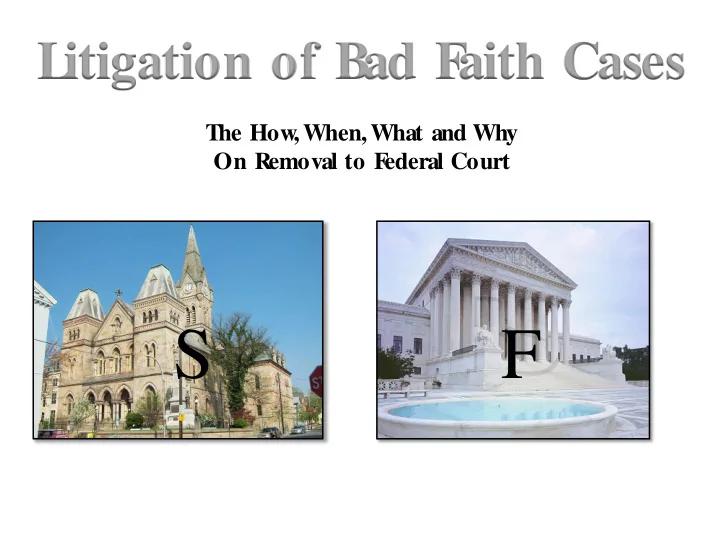

L itigation of B ad F aith Cases The How , When, What and Why On Removal to F ederal Court S F
Removal of Civil Actions 28 U.S.C.A. § 1441 A civil action brought in a State court of which the district courts of the United States have original jurisdiction, may be removed by the defendant or the defendants, to the district court of the United States for the district and division embracing the place where such action is pending.
Basis of Federal Jurisdiction 28 U.S.C.A. § 1332(a) (“Diversity Cases”) Amount in controversy must exceed 75K, exclusive of interests and costs Diversity of citizenship of parties A civil action otherwise removable solely on the basis of the jurisdiction under SECTION 1332(A) of this title may not be removed if any of the parties in interest properly joined and served as defendants is a citizen of the state in which such action is brought. 28 U.S.C.A. § 1441.
“HOW” Procedure for Removal to Federal Court 28 U.S.C.A. § 1446 Defendant shall: File a Notice of Removal (containing a short and plain statement of the grounds for removal) in the District Court. File a copy of the Notice of Removal with the State Court, which shall effect the removal and the State court shall proceed no further unless and until the case is remanded. Secure consent of all other defendants served in State Court case. Evidence consent by having said defendants either sign the Notice of Removal, file their own Notice of Removal, or file a written consent or written joinder to the original notice of removal. Ogletree v. Barnes, 851 F. Supp. 184, 190 (E.D. Pa. 1994)
“WHEN” When does Removal to Federal Court Occur? • Notice of Removal to be filed within 30 days of receipt by defendant, through service or otherwise, of a copy of the initial pleading setting forth the claim for relief. - A Civil Cover Sheet does not trigger the 30 days. Polanco v. Coneqtec Universal, 474 F. Supp. 2d 735, 736 (E.D. Pa. 2007)(Mem. Op. Judge Bartle). - Writ of summons alone can no longer be the “initial pleading” that triggers the 30– day period for removal. Sikirica v. Nationwide Ins. Co., 416 F.3d 214, 223 (3d Cir. 2005). • If the case stated by the initial pleading is not removable, a notice of removal may be filed within 30 days after receipt by the defendant, through service or otherwise, of a copy of an amended pleading, motion, order or other paper from which it may first be ascertained that the case is one which is or has become removable. - “Other Paper” may include information on the docket in the State Court case or information received in discovery responses in the State Court case. • A case may not be removed on the basis of jurisdiction conferred by section 1332 more than 1 year after commencement of the action, unless the court finds that the plaintiff has acted in bad faith in order to prevent a defendant from removing the action. Eg. Fraudulent joinder of non- diverse defendant to prevent removal and later withdrawing claim. - The date of commencement is determined by the plaintiff's filing date of his writ of summons or complaint. Spanier v. Freeh, 2014 PA Super 133, 95 A.3d 342, 347 (2014).
“WHEN” Motion to Remand • A Motion to Remand on the basis of any defect other than lack of subject matter jurisdiction must be made within 30 days after the filing of the Notice of Removal. - Defective Removal Procedure - Judicial Economy • An order remanding the case may require payment of just costs and any actual expenses, including attorney fees, incurred as a result of the removal. • Remand order to state court premised on defective removal procedure or lack of jurisdiction is not appealable. But remand order can be reviewed on appeal where remand was discretionary decision declining the exercise of expressly acknowledged jurisdiction. 28 U.S.C.A. § 1447 (West)
“WHAT” What determines “Amount in Controversy (AIC)?” Generally, the Face of the Complaint Controls. But if the State practice either does not permit demand for a specific sum or permits recovery of damages in excess of the amount demanded, and District court finds, by the preponderance of the evidence, that the amount in controversy exceeds 75k, removal is appropriate. Federal Courts Jurisdiction and Venue Clarification Act, 28 U.S.C. 1446.
“WHAT” What is considered as part of AIC? Breach of Contract for Value of Coverage Denied. Statutory Bad Faith Case: Interest on Claim at Prime plus 3%; Attorney’s Fees; and Punitive Damages. Claims for punitive damages may be aggregated with compensatory damages in determining the amount in controversy. Valley v. State Farm Fire & Cas. Co., 504 F. Supp. 2d 1, 5 (E.D. Pa. 2006)
“WHAT” What is considered to determine Diversity of Citizenship? Diversity statute applies only to cases in which the citizenship of each plaintiff is diverse from the citizenship of each defendant. Citizenship of Defendant-Insurer: Based on (1) State of incorporation and (2) State where it has its principal place of business. Agostini v. Piper Aircraft Corp., No. CIV. A. 11-7172, 2012 WL 646025, at *3 (E.D. Pa. Feb. 29, 2012)
Issue of Fraudulent Joinder to Destroy Diversity Plaintiff may not destroy a defendant's right of removal by fraudulently or improperly joining a resident defendant. Contest as to whether joinder of individual claims adjuster from state where insured resides is fraudulent or improper? Ozanne v. State Farm, 2011 WL 1743683 (W.D. Pa. May 5, 2011) (Court recognized that a colorable UTPCPL claim may exist against an insurance adjuster.”) Hennessy v. Allstate Ins. Co., 2014 WL 7232119 (Pa.Com.Pl.)(Court overruled P.O.s of insurer challenging inclusion of negligence and UTPCPL claims against insurance adjusters).
“WHY” Why would a defendant-insurer in bad faith action prefer federal court? Considerations: • Bench vs. Jury Trial • Speed of Litigation • Single Judge Assignment • Discovery Precedent
Recommend
More recommend